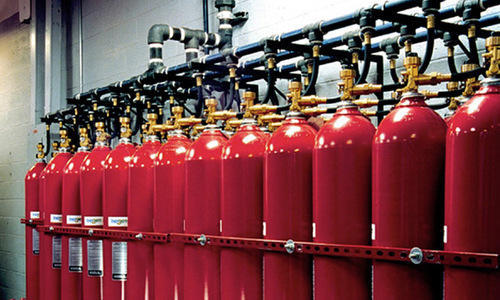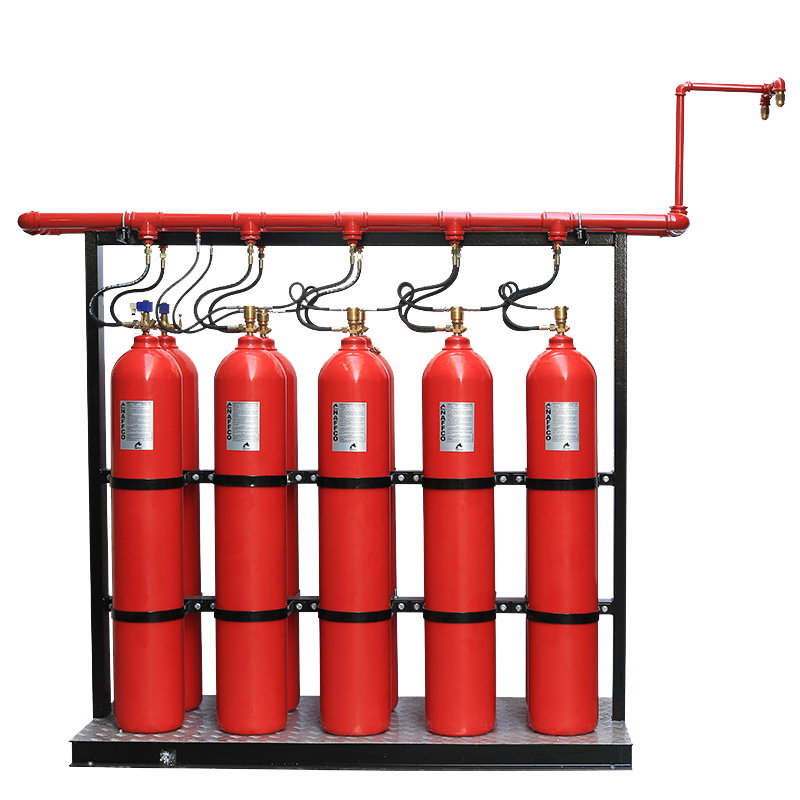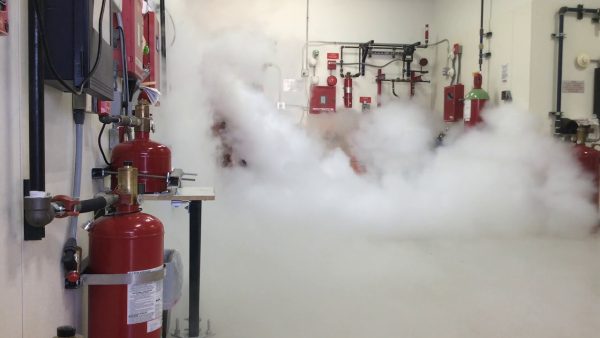

CO2 SUPPRESSION SYSTEM
A CO2 fire suppression system puts out fires by removing oxygen. When smoke or fire is detected, it releases CO2 into the area.
Different fire suppression systems use different agents. Clean agents or inert gases are used in places like server rooms where people are around. CO2 systems are used in areas with few or no people, such as engine rooms, generator rooms, power stations, flammable liquid storage areas, and large industrial machines.
While CO2 fire suppression systems are extremely effective at putting out fires, the CO2 agent is also hazardous to one’s health when compared to other agents. As a result, CO2 fire suppression systems are most commonly found in unoccupied buildings.
Fire Suppression System
Fire suppression systems are designed to suppress or extinguish a fire in sensitive environments where water from a fire sprinkler is not a desired extinguishing agent. There are a few different types of agents that are used in a suppression system to suppress the fire. In server rooms and environments where you have personnel working in the area, you will usually find clean agent or inert gas suppression systems. In environments where there are few personnel or none at all, you will typically find CO2 fire suppression systems. The areas that you’ll find CO2 fire suppression systems include engine rooms, generator rooms, power stations, flammable liquid storage rooms, and around large industrial machines.
What is a CO2 Fire Suppression System?
While CO2 fire suppression systems are highly effective at suppressing fires, the CO2 agent also poses a health risk when compared to the other agents. For this reason, you’ll find CO2 fire suppression systems most often in non-occupied environments. CO2 fire suppression system is extremely versatile and effective on a wide range of flammable and combustible materials that been approved for Class A, B and C hazards. CO2 is a colourless, odourless, electrically non-conductive gas that is highly efficient as a fire suppression agent and leaves no residue behind. CO2 fire protection systems use intelligent, reliable and fast-acting control panels to quickly sense a fire before it can cause damage to property. CO2 gas has a high rate of expansion, which allows a CO2 fire protection system to work fast.

CO2 fire protection systems are available for use in total flooding or local fire protection applications and are ideal for protecting high value assets where large quantities of agent is required.
These include dip tanks, rolling mills, data processing centers, vaults/tape storage and marine machinery spaces – making it an effective fire protection system for a wide variety of hazards.
CO2 Suppression System Calculator
Disclaimer: This calculator is only to be used as guidance and does not provide the definitive answer.
How Does a CO2 Fire Suppression System Put Out a Fire?
A fire needs oxygen, fuel, and heat to keep burning. Removing any of these will stop the fire. A CO2 fire suppression system works by removing oxygen.
When smoke or fire is detected, the system releases CO2 into the protected area. The CO2 quickly fills the space, lowering oxygen levels so the fire can’t burn. CO2 creates a heavy gas blanket that puts out the fire without leaving any mess.
Because it’s a gas, CO2 won’t damage sensitive equipment, helping reduce downtime and repair costs. Once the CO2 has safely cleared, people can return, check for damage, and resume work without needing to clean up.

Is a CO2 Fire Suppression System Dangerous?
CO2 can be dangerous to humans even at 7.5% concentration. CO2 fire suppression systems usually release around 34% concentration to flood the protected area and put out the fire. Because of this risk, these systems must include safety features to protect people nearby.
One safety feature is a loud siren that warns people before CO2 is released. It’s also important to train all staff on the dangers of CO2 and how to safely evacuate if the system is about to activate.
The good news is AITO has capable technician that can possess the required abilities and information.


